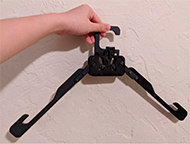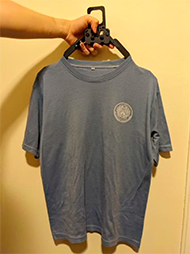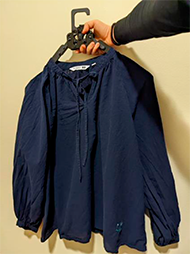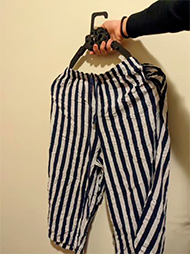Accesstive Hanger For People With An Upper Extremity Impairment
Chaniya Jaroenkunathum, Suann Chi, Emily Crane,Sharadhi Bharadwaj, Mary Priyanka Jacob
Carnegie Mellon University
Problem Statement/Research Question and Background
The accessible hanger targets users with an upper extremity impairment affecting one limb or hand. This includes users with congenital anomalies affecting the structure or strength of the arm or hand, people who have had amputations, and people with illnesses or injuries causing monoplegia or monoparesis.
There are already approximately 2 million Americans living with limb loss with another 100,000 amputations performed every year. About 25% of those amputations affect the upper extremities, of which about 70% are below the elbow amputations [2]-[3].
Congenital anomalies are present in 1-2% of live births. Of these anomalies, about 10% affect the upper limbs, resulting in an incident rate of about 0.01- 0.02% of the population [1]. In the United States, this means that about 66,000 people have congenital anomalies affecting the upper limbs.

Possible causes of monoplegia are peripheral nerve compression due to tumors or other injuries to the brain or spinal cord, and neurological diseases such as multiple sclerosis (MS), amyotrophic lateral sclerosis (ALS), monomelic amyotrophy (MMA), and stroke. There are about 7 million stroke survivors in the United States. It is estimated that 50 to 80% of strokes result in upper limb impairment with most estimates at about 75%. A significant number of sufferers will never regain the use of the affected arm. Even by conservative estimates, this means that there are 3.5 million people affected by the weakness, spasticity, and contracture of the upper limbs that follow a stroke [4]-[6].
People in the early stages of multiple sclerosis would also benefit from an accessible clothes hanger. The symptoms of early multiple sclerosis include decreased sensation, numbness, and tingling in the arms and hands. This can cause decreases in the tactile sensation that make it difficult to hold objects. Upper extremity weakness and intention tremor are also common, making grasping movements very difficult.


This led to our research question - "How can we enable users who are experiencing these conditions to easily place their clothes on a clothes hanger for storage and remove the articles of clothing from the hanger for wear?" Thus, we design this assistive hanger to help them dress up easier.
Methods/Approach/Solutions Considered
Our design method is to create the assistive hanger that the user can use a single hand to hang and remove the cloth from the hanger, with no extra associate needed. The proposed accessible hanger will make dressing oneself, a key activity of daily living, much easier for users in these groups by reducing the manual dexterity and coordination required to hang clothes or remove clothes from a hanger and allowing these actions to be performed with a single hand.
There are some interesting devices that we found during the literature review. One of these devices is the Open-ended hanger designed by Eisho Co., Ltd[7]. It helps users insert the hanger into the cloth and hang it easily. There are some drawbacks to these designs, cloth can easily slide off the open end, especially while hanging in the closet.


Thus, we design a foldable hanger that can hang the clothes without slipping off. This hanger can fold (close) and unfold (expand) the hanger arms with the lock and unlock mechanism. This foldable function is for easy insertion of the hanger into the cloth and easy removal of the cloth from the hanger.
Description of Final Approach and Design
The assistive hanger uses a Pin-in-a-Slot mechanism to enable users to close and expand the hanger arms, for easy insert and taking off the cloth. In this model, the user can use only one hand to close and expand the hanger arms. The user can begin by placing the cloth on a surface and inserting the folded hanger into the cloth. Once the hanger is placed inside, the user can then use the locking mechanism to expand the arms of the hanger and hold the arms in position. The locking mechanism is a simple one that includes a slider on the ring of the hanger, the slider opens the arms of the hanger when moved and this slider can then be locked in position using a hook-like structure from the arms. Hence, the arms remain extended until the user slides the slider again to free the cloth from the hanger.
Outcome (Results of any outcomes testing and/or user feedback)


The product outcome from the design is made from acrylic, for the design concept proof. The result shows that users can fold for insert into the cloth and remove the cloth for wearing and unfold the hanger arms for holding and hanging the cloth.
We test this prototype by using the hanger with different types of cloth, this hanger can be used with various clothes such as T-shirts, blouses, and Relaco pants. However, we have not yet gotten any user feedback because we have not brought this prototype to the user.
Cost (Cost to produce and expected pricing)
The prototype designed and made for this project made use of the following materials:
| Material Used | Cost price |
| Black A1 Matte Acrylic sheet (18" x 24") | $25 |
| Acrylic bonding glue | $5 |
| Laser cutting | $5 |

Considering these prices, we can safely assume that just for the prototype, we have spent $35 which can make 3-4 hangers from these materials, and thus it could be sold for a price of $15, or even lowered to the price of $10.
On a large-scale production, the device can be redesigned for manufacturing processes such as plastic molding production, with similar mechanisms. Plastic injection molding can reduce the material prices and the number of parts in this device. The price per piece would go much lower than the prototype model; the weight and size of the new material should also be lighter and smaller than the prototype. Thus, shipping and packaging costs when selling the product could be reduced. We should do online marketing on the social media platform, to minimize the marketing spend, which can ensure that the product is very much affordable and can be purchased in bulk.
Significance
The designed product will provide great support to the targeted user group and can improve their quality of life following these features:
- Ease of Use: The accessible hanger is very easy to use and can be learned to use in 5 mins. The user requires minimal arm strength to push down the hook of the hanger and slide the lock into place to make the hanger sit tight. People with only one upper limb can use this hanger to easily hang and remove the cloth. Without the use of two hands or excess hand stability or muscle power; the users can leverage the benefits of hangers.
- Portable and Dependable: The hanger is made from a light material (Acrylic for the prototype or plastic molding for production), thus it is portable and dependable.
- Better maintenance of clothes: Hangers are very useful in preventing clothes from wrinkling, better organization of the closet, and faster access to items within the closet.
References
- E. N. F. Bisneto, "CONGENITAL DEFORMITIES OF THE UPPER LIMBS.," Rev. Bras. Ortop., vol. 47, no. 5, pp. 545–552, Nov. 2015, doi: 10.1016/S2255-4971(15)30002-1.
- P. Maduri and H. Akhondi, "Upper Limb Amputation," in StatPearls, Treasure Island (FL): StatPearls Publishing, 2021. Accessed: Nov. 29, 2021. [Online]. Available: http://www.ncbi.nlm.nih.gov/books/NBK540962/
- M. P. Fahrenkopf, N. S. Adams, J. P. Kelpin, and V. H. Do, "Hand Amputations," Eplasty, vol. 18, p. ic21, Sep. 2018.
- J. Barth, S. Geed, A. Mitchell, P. S. Lum, D. F. Edwards, and A. W. Dromerick, "Characterizing upper extremity motor behavior in the first week after stroke," PLOS ONE, vol. 15, no. 8, p. e0221668, Aug. 2020, doi:10.1371/journal.pone.0221668.
- R. Allison, L. Shenton, K. Bamforth, C. Kilbride, and D. Richards, "Incidence, Time Course and Predictors of Impairments Relating to Caring for the Profoundly Affected arm After Stroke: A Systematic Review," Physiother Res Int, vol. 21, no. 4, pp. 210–227, Dec. 2016, doi:10.1002/pri.1634.
- L. A. Ingram, A. A. Butler, M. A. Brodie, S. R. Lord, and S. C. Gandevia, "Quantifying upper limb motor impairment in chronic stroke: a physiological profiling approach," Journal of Applied Physiology, vol. 131, no. 3, pp. 949–965, Sep. 2021, doi:10.1152/japplphysiol.00078.2021.
- EISHO CO., LTD. 2022. Open end metal hanger with foam good for pants. [online] Available at: https://www.eishoo.com/product-antislip-metal-hanger-with-foam-good-for-pants.html [Accessed 15 April 2022].